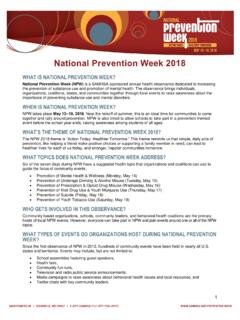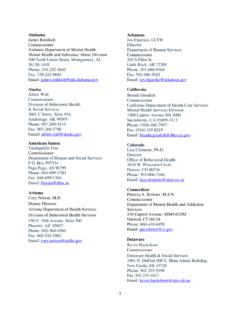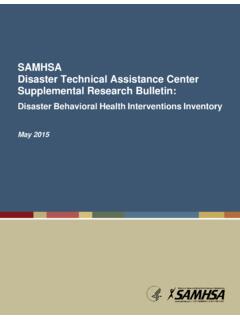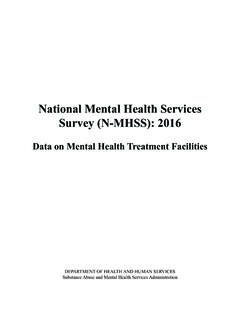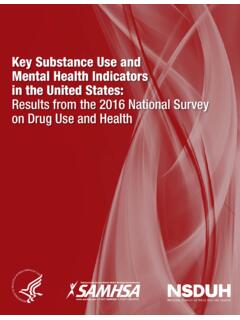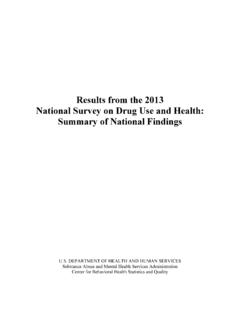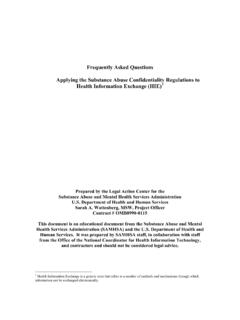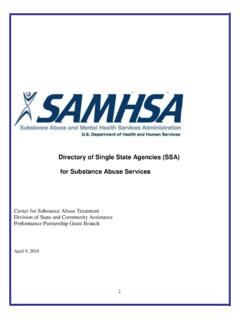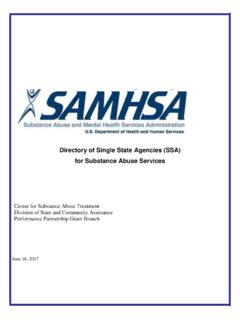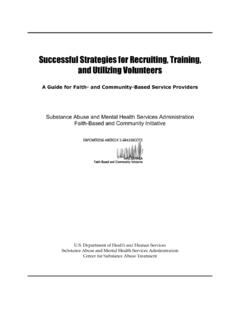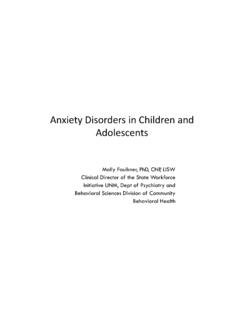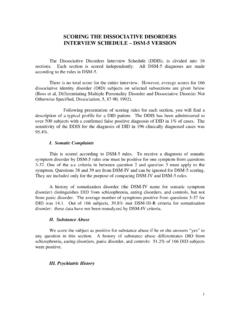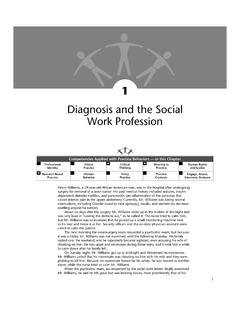Transcription of DSM-5 Changes: Implications for Child Serious Emotional ...
1 DSM-5 Changes: Implications FOR CHILDSERIOUS EMOTIONALDISTURBANCE DISCLAIMER SAMHSA provides links to other Internet sites as a service to its users and is not responsible for the availability or content of these external sites. SAMHSA, its employees, and contractors do not endorse, warrant, or guarantee the products, services, or information described or offered at these other Internet sites. Any reference to a commercial product, process, or service is not an endorsement or recommendation by SAMHSA, its employees, or contractors. For documents available from this server, the Government does not warrant or assume any legal liability or responsibility for the accuracy, completeness, or usefulness of any information, apparatus, product, or process disclosed.
2 Substance Abuse and Mental Health Services Administration Center for Behavioral Health Statistics and Quality Rockville, Maryland 20857 June 2016 This page intentionally left blank DSM-5 CHANGES: Implications FOR Child Serious Emotional DISTURBANCE Contract No. HHSS283201000003C RTI Project No. RTI Authors: Heather Ringeisen Cecilia Casanueva Leyla Stambaugh SAMHSA Authors: Jonaki Bose Sarra Hedden RTI Project Director: David Hunter SAMHSA Project Officer: Peter Tice For questions about this report, please e-mail Prepared for Substance Abuse and Mental Health Services Administration, Rockville, Maryland Prepared by RTI International, Research Triangle Park , N orth Carolina June 2016 Recommended Citation: Center for Behavioral Health Statistics and Quality.
3 (201 6). 2014 National Survey on Drug Use and Health: DSM-5 Changes: Implications for Child Serious Emotional Disturbance (unpublished internal documentation). Substance Abuse and Mental Health Services Administration, Rockville, MD. ii Acknowledgments This publication was developed for the Substance Abuse and Mental Health Services Administration (SAMHSA), Center for Behavioral Health Statistics and Quality (CBHSQ), by RTI International, a trade name of Research Triangle Institute, Research Triangle Park, North Carolina, under Contract No. HHSS283201000003C. Contributors to this report include Lisa Colpe and Peggy Barker. At RTI, Michelle Back edited and Roxanne Snaauw formatted the report. iii Table of Contents Chapter Page 1.
4 Introduction .. Definition of SED .. 1 Published SED Estimates .. 2 to DSM-5 Changes: Overview .. Elimination of the Multi-Axial System and GAF Score .. 5 Disorder Reclassification .. 5 -5 Child Mental Disorder Classification .. New Childhood Mental disorders Added to the DSM-5 .. 9 Social (Pragmatic) Communication Disorder (SCD, under Neurodevelopmental disorders ) .. 9 Disruptive Mood Dysregulation Disorder (or DMDD) (under Depressive disorders ) .. 11 Age-Related Diagnostic criteria Changes to Mental disorders in the DSM-5 .. 16 Attention-Deficit/Hyperactivity Disorder (ADHD, under Neurodevelopmental disorders .. 16 Post-traumatic Stress Disorder (PTSD, under Trauma- and Stressor-Related disorders ).)
5 20 Changes to Other Mental disorders with Minor to No Implication for SED Prevalence Estimates .. 24 Major Depressive Episode/Disorder (under Depressive disorders ) .. 24 Persistent Depressive Disorder (formerly Dysthymic Disorder, under Depressive disorders ) .. 25 Manic Episode and Bipolar I Disorder (under Bipolar and Related disorders ) .. 26 Generalized Anxiety Disorder (under Anxiety disorders ) .. 34 Panic Disorder and Agoraphobia (under Anxiety disorders ) .. 35 Separation Anxiety Disorder (under Anxiety disorders ) .. 39 Social Anxiety Disorder (formerly Social Phobia [Social Anxiety Disorder], under Anxiety disorders ) .. 40 Conduct Disorder (under Disruptive, Impulse-Control, and Conduct disorders ).
6 42 Oppositional Defiant Disorder (under Disruptive, Impulse-Control, and Conduct disorders ) .. 45 Eating disorders (under Feeding and Eating disorders ) .. 47 Body Dysmorphic Disorder (under Obsessive-compulsive and Related disorders ) .. 52 4. Instrumentation .. 555. Summary and Conclusions .. 59 References .. 61 iv List of Tables Table Page 1. DSM -IV Childhood Mental disorders Assessed in Leading Studies with Published Estimates of SED .. 3 2. Past 12-month Prevalence of Mental disorders Based upon the NCS-A, NHANES Special Study, and GSMS, by Functional Impairment and Child Age .. 4 3. Disorder Classes Presented by the DSM-IV and DSM-5 , as Ordered in DSM-IV .. 6 4. Disorder Classification in the DSM-IV and DSM-5 for disorders Usually First Diagnosed in Infancy, Childhood, or Adolescence.
7 7 5. DSM -IV Pervasive Developmental Disorder Not Otherwise Specified (PDD-NOS) to DSM-5 Social (Pragmatic) Communication Disorder (SCD) Comparison .. 10 6. DSM -IV Bipolar Disorder-Manic Episode and Oppositional Defiant Disorder to DSM -5 Disruptive Mood Dysregulation Disorder (or DMDD) Comparison .. 12 7. DSM -IV to DSM-5 Attention-Deficit/Hyperactivity Disorder Comparison .. 17 8. DSM -IV to DSM-5 Post-traumatic Stress Disorder Comparison Children 6 Years and Younger .. 21 9. DSM -IV to DSM-5 Major Depressive Episode/Disorder Comparison .. 25 10. DSM -IV to DSM-5 Dysthymic Disorder/Persistent Depressive Disorder Comparison .. 26 11. DSM -IV to DSM-5 Manic Episode criteria Comparison .. 28 12. DSM -IV to DSM-5 Bipolar I Disorder Comparison.
8 29 13. DSM -IV to DSM-5 Generalized Anxiety Disorder Comparison .. 34 14. Panic Disorder and Agoraphobia criteria Changes from DSM-IV to DSM-5 .. 36 15. DSM -IV to DSM-5 Separation Anxiety Disorder Comparison .. 39 16. DSM -IV to DSM-5 Social Phobia/Social Anxiety Disorder Comparison .. 41 17. DSM -IV to DSM-5 Conduct Disorder Comparison .. 43 18. DSM-IV to DSM-5 Oppositional Defiant Disorder Comparison .. 46 19. DSM -IV to DSM-5 Anorexia Nervosa Comparison .. 48 20. DSM -IV to DSM-5 Bulimia Nervosa Comparison .. 49 21. DSM -IV to DSM-5 Binge Eating Disorder Comparison .. 50 22. DSM -IV to DSM-5 Avoidant/Restrictive Food Intake Disorder Comparison .. 52 23. DSM-IV to DSM-5 Body Dysmorphic Disorder Comparison.
9 54 24. Summary of Diagnostic Instruments Used to Assess Child Mental disorders .. 55 v This page intentionally left blank 1 1. IntroductionThe Diagnostic and Statistical Manual of Mental disorders (DSM) is the manual used by clinicians and researchers to diagnose and classify mental disorders (including substance use disorders [SUDs]). The DSM specifically classifies Child disorders by symptoms, duration, and functional impact across home, school, and other community settings. The American Psychiatric Association (APA) published the DSM-5 in 2013, culminating a 14-year revision process. This latest revision takes a new approach to defining the criteria for mental disorders a lifespan perspective. This perspective is very relevant to diagnosing childhood mental disorders .
10 The perspective recognizes the importance of age and development in the onset, manifestation, and treatment of mental disorders . The purpose of this report is to describe the differences between the DSM-IV and DSM-5 diagnostic criteria that could affect national estimates of childhood Serious Emotional disturbance (SED). The report also provides a description of DSM-5 updates that have been made (or are being made) to existing diagnostic instruments and screeners of childhood Emotional and behavioral health. Definition of SED The DSM has never offered a definition of SED. This term has been defined historically by the Substance Abuse and Mental Health Services Administration (SAMHSA) and released as a Federal Register notice.
